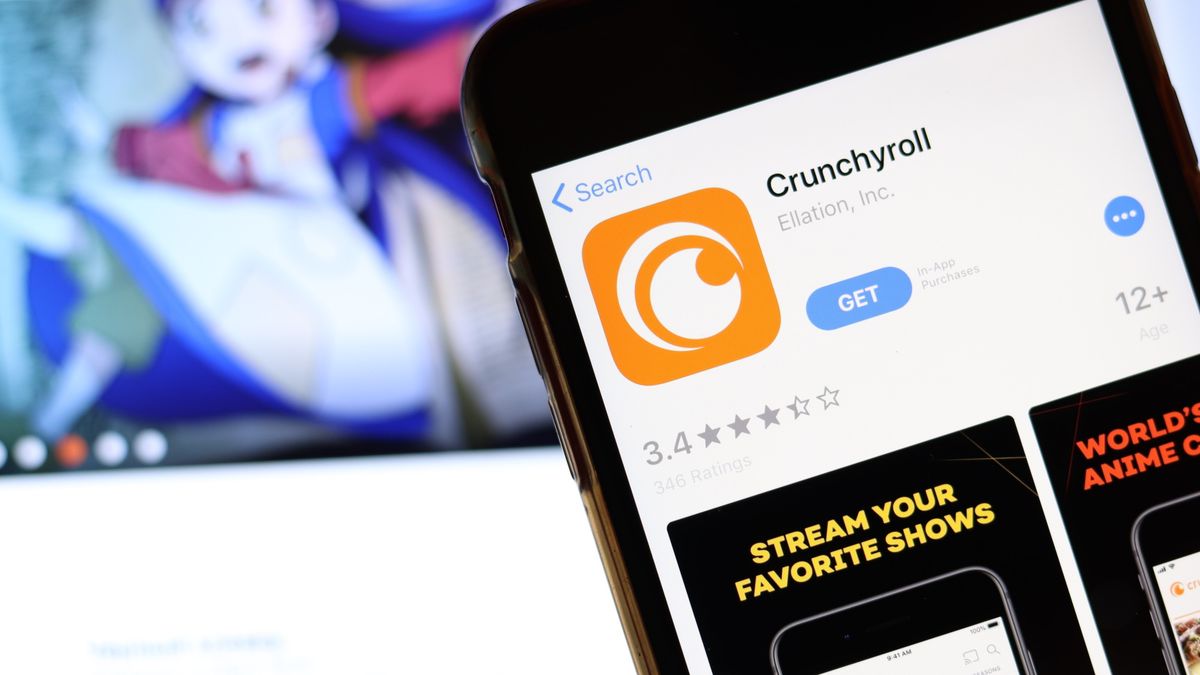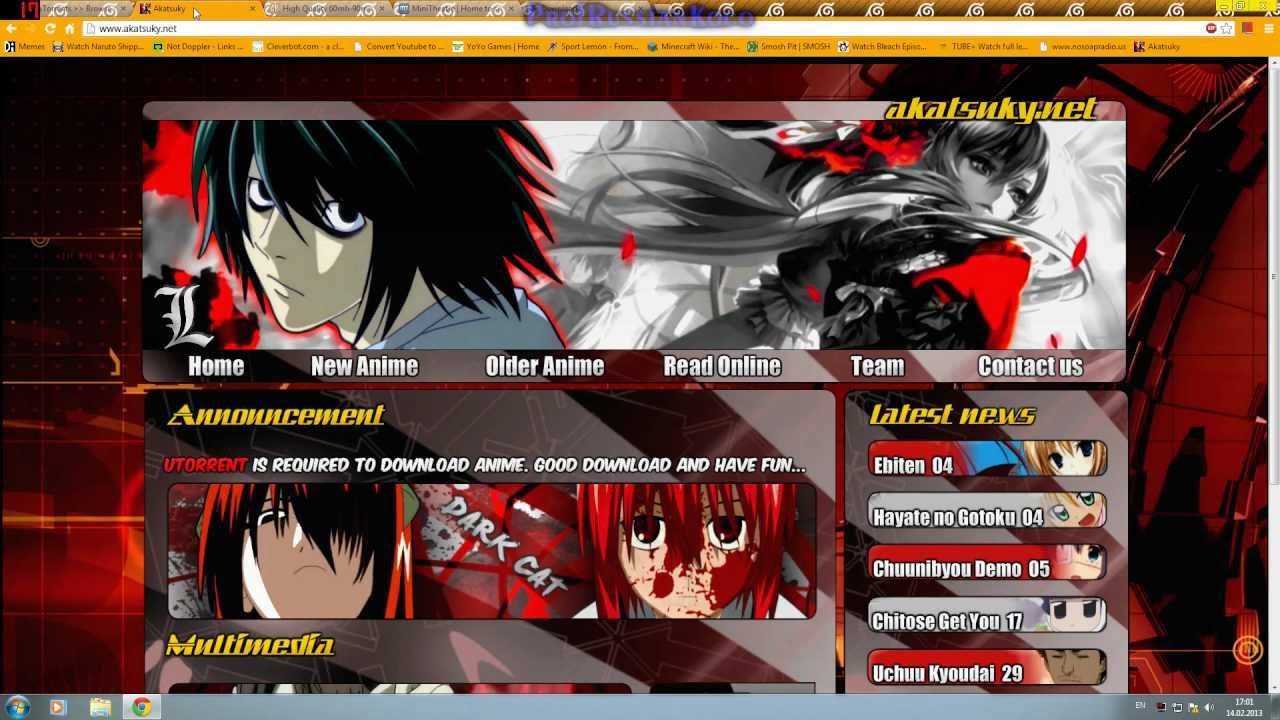Introduction
Welcome to the exciting world of anime! Whether you’re a seasoned fan or new to the genre, finding the best ways to watch anime and dive into its captivating stories can be a thrilling journey. Anime, an abbreviated term for “animation” in Japanese, has gained immense popularity worldwide for its unique art style, diverse genres, and immersive storytelling.
With the advancement of technology and the popularity of streaming platforms, accessing your favorite anime has become easier than ever. However, figuring out where and how to start can be overwhelming. Don’t worry, though, as this guide will take you through the essential steps to watch anime and make the most of your experience.
When it comes to watching anime, finding a reliable streaming platform is crucial. The good news is that there are numerous platforms such as Crunchyroll, Funimation, and Netflix that offer an extensive collection of anime series and movies. Some platforms even provide simulcast releases, allowing you to watch the latest episodes as they air in Japan.
In order to make your anime-watching journey more organized, creating a watchlist is highly recommended. Add the series and movies you’re interested in to your watchlist so you can easily keep track of what you want to watch next. Many streaming platforms offer this feature, allowing you to curate your personal anime library.
Understanding different anime genres is also crucial in finding the perfect series that suits your preferences. Whether you’re into action-packed shounen shows, heartwarming slice-of-life dramas, or gripping psychological thrillers, knowing the genres can help you narrow down your choices and discover hidden gems.
As you delve into the world of anime, you’ll come across unique terminology that may seem unfamiliar at first. Words like “otaku,” “manga,” and “cosplay” are commonly used within the anime community. Embracing these terms will not only enhance your understanding of anime but also make you feel like a part of the vibrant culture surrounding it.
Finding a Suitable Streaming Platform
With the increasing popularity of anime, there are now numerous streaming platforms available that offer a wide range of shows and movies. However, not all platforms are created equal, and finding a suitable one can greatly enhance your anime-watching experience.
One of the most well-known streaming platforms for anime is Crunchyroll. Known for its vast library of Japanese animated content, Crunchyroll offers a wide variety of genres, including shounen, romance, fantasy, and more. It also provides simulcast releases, allowing you to watch the latest episodes of popular series shortly after they air in Japan. Additionally, Crunchyroll offers both free and premium subscription options, giving you the flexibility to choose what suits you best.
Another popular platform is Funimation, which specializes in English dubbed anime. It offers a vast collection of dubbed shows and movies, making it an excellent choice for those who prefer watching anime in English. Funimation also provides simulcast releases and has an extensive library of classic and popular titles.
If you’re looking for a more diverse selection of content, Netflix is a great option. While not exclusively dedicated to anime, Netflix has an impressive anime library, including original series like “Castlevania,” “The Seven Deadly Sins,” and “Devilman Crybaby.” It also offers a mix of dubbed and subbed options, allowing you to choose your preferred viewing experience.
In addition to these popular platforms, there are other streaming services like Hulu, Amazon Prime Video, and AnimeLab that offer a wide range of anime titles. Each platform has its own unique features and content offerings, so it’s worth exploring multiple options to find the perfect fit for your anime preferences.
When choosing a streaming platform, consider factors such as the availability of subtitles, video quality, user interface, and the platform’s commitment to supporting the anime industry. Some platforms, like Crunchyroll and Funimation, have partnerships with anime production companies, ensuring that your support goes directly to the creators. By making an informed decision about which streaming platform to use, you can enjoy anime in the best possible way while also contributing to the industry’s growth.
Creating a Watchlist
When it comes to exploring the vast world of anime, it’s easy to get overwhelmed with the sheer number of series and movies available. That’s why creating a watchlist is an essential step in organizing and prioritizing the anime you want to watch.
A watchlist is essentially a personalized list of anime titles that you plan to watch. It’s a convenient way to keep track of what you’re interested in and ensure that you don’t miss out on any captivating shows.
To start building your anime watchlist, consider your preferences and interests. Are you drawn to action-packed shounen series, heartwarming slice-of-life dramas, intricate psychological thrillers, or perhaps a mixture of genres? Knowing your preferences will help you narrow down the list and focus on the anime that is most likely to resonate with you.
There are several ways you can create and maintain your anime watchlist. One of the simplest ways is to use an online platform or app dedicated to tracking your anime-watching progress. Websites like MyAnimeList and Anime-Planet offer user-friendly interfaces where you can search for specific shows, add them to your watchlist, and mark episodes as watched as you progress through them.
If you prefer a more traditional approach, you can also create a physical watchlist by writing down the titles of the anime you want to watch on a notebook or using a dedicated section in a journal. This can be a fun and tangible way to keep track of your anime journey.
As you explore different anime series, your watchlist may grow larger. It’s important to periodically review and prioritize the titles on your list. Consider factors such as the genre, popularity, recommendations from friends or online communities, and personal interests. This will help you determine which shows to watch next and avoid feeling overwhelmed by the sheer number of options available.
Remember, your watchlist is a flexible tool that can be adjusted and updated as needed. If you discover a new anime that catches your attention, don’t hesitate to add it to your list. On the other hand, if you realize that a particular series is not as appealing as you initially thought, you can remove it and replace it with another that piques your interest.
Having a watchlist not only keeps your anime-watching journey organized but also builds anticipation as you look forward to each new series you plan to dive into. It’s a simple yet effective way to ensure that you don’t miss out on any of the amazing anime waiting to be discovered.
Selecting the Right Genre
Anime offers a wide range of genres, each with its own unique storytelling style and themes. When diving into the world of anime, selecting the right genre can greatly enhance your viewing experience. Whether you’re a fan of action, romance, fantasy, or something in between, there’s an anime genre that’s perfect for you.
One of the most popular genres in anime is shounen, which targets a younger male audience and focuses on action, adventure, and often features epic battles and powerful main characters. Series like “Naruto,” “One Piece,” and “Dragon Ball” fall under this genre and offer thrilling, action-packed storylines that keep viewers on the edge of their seats.
For those who enjoy heartwarming and relatable stories, the slice-of-life genre is a great choice. These anime focus on everyday experiences and often depict realistic characters in various life situations. Series like “K-On!,” “Barakamon,” and “Your Lie in April” offer heartwarming narratives that explore themes of friendship, love, and personal growth.
If you’re looking for a mix of action and romance, the shoujo genre might be perfect for you. Targeting a younger female audience, shoujo anime often center around themes of love, friendship, and self-discovery. Series like “Fruits Basket,” “Ouran High School Host Club,” and “Kamisama Kiss” beautifully combine romance and adventure.
For those who appreciate thought-provoking and complex storylines, the psychological genre provides a deep dive into the human mind. These anime explore themes of the subconscious, identity, and moral dilemmas. Series like “Death Note,” “Psycho-Pass,” and “Monster” challenge the viewer’s perception and keep them guessing until the very end.
Other popular anime genres include fantasy, science fiction, comedy, horror, and sports. Each has its own unique appeal and offers a plethora of captivating series and movies to choose from. Exploring different genres can broaden your anime-watching experience and introduce you to new and exciting narratives.
When selecting the right genre, it’s important to consider your personal preferences and interests. Reflect on the types of stories, themes, and emotions you enjoy the most. If you’re unsure, don’t be afraid to experiment with different genres to see what resonates with you.
Remember, anime is not limited to one particular genre, and many series blend elements from multiple genres to create a rich and captivating story. Don’t be afraid to step out of your comfort zone and try something new. You might discover a hidden gem that becomes one of your favorite anime series!
Understanding Anime Terminology
As you delve into the world of anime, you’ll come across various unique terms and expressions that are frequently used within the anime community. Understanding these terminologies will not only enhance your appreciation of anime but also help you connect with fellow fans. Here are some common anime terms you should familiarize yourself with:
Otaku: This term refers to an individual who is highly passionate about anime and manga. It is often used to describe someone who is deeply immersed in the anime culture and has an extensive knowledge of the medium.
Manga: Manga refers to Japanese comic books or graphic novels. Many popular anime series are adapted from manga, which often serves as the source material for anime production.
Cosplay: Cosplay is the practice of dressing up as a character from anime, manga, or video games. It has become a popular hobby and is often seen at anime conventions and events.
AMV: Short for Anime Music Video, AMV refers to videos created by fans that combine anime footage with music. AMVs are a creative way for fans to showcase their favorite anime and express their artistic talents.
Filler: In anime, filler episodes or arcs are non-canon or unrelated to the main plot. They are often used to give the manga time to progress or as a way to extend the series. Filler episodes typically have self-contained narratives and may not contribute to the overarching story.
Fan Service: Fan service refers to elements in anime that are designed to cater to fans’ desires, often in a more provocative or sensual manner. This can include suggestive scenes, revealing outfits, or romantic interactions between characters.
Seiyuu: Seiyuu refers to the voice actors and actresses who lend their voices to characters in anime. They play a crucial role in bringing the characters to life and conveying their emotions.
OP/ED: OP stands for Opening, while ED stands for Ending. These refer to the opening and ending theme songs of an anime series. They often provide a glimpse into the visual style and tone of the series and can become iconic in their own right.
Fanart: Fanart refers to artwork created by fans that depict characters or scenes from anime. It is a way for fans to showcase their artistic talents and express their love for their favorite series.
Subs and dubs: Subs stand for subtitles, while dubs refer to dubbed versions of anime where the dialogue is translated and voiced in a language other than the original Japanese. Subs are often preferred by purists who want to experience the anime in its original form, while dubs cater to those who prefer to watch anime in their native language.
By familiarizing yourself with these common anime terminologies, you’ll feel more connected to the anime community and better equipped to engage in conversations about your favorite shows. It’s these unique terms that contribute to the rich and vibrant culture surrounding anime.
Subbed vs. Dubbed: Which one to choose?
When it comes to watching anime, one of the decisions you’ll often need to make is whether to watch it with subtitles (subbed) or with a dubbed version. Both options have their advantages, and the choice ultimately depends on your personal preferences and viewing experience.
Subbed anime refers to shows that have been translated from Japanese to other languages, typically English, and have subtitles displayed at the bottom of the screen. This allows you to hear the original voices of the characters and experience the anime as intended by the creators. Subtitles also help in understanding the nuances of the language and capturing the emotion in the voice acting.
On the other hand, dubbed anime has been re-recorded with voice actors speaking in a language other than Japanese. The dialogue is synchronized with the animation, eliminating the need for subtitles. This can make it easier to follow the story and appreciate the visuals without constant reading.
The choice between subbed and dubbed ultimately comes down to personal preference and the aspects of anime that you value most. To help you make an informed decision, consider the following factors:
- Authenticity: Subbed anime provides a more authentic experience as you hear the original voice acting and language used by the creators. It allows you to fully appreciate the nuances and emotions portrayed by the voice actors.
- Presentation: Dubbed anime can be more accessible for viewers who may find it difficult to read subtitles while keeping up with the visuals. It allows for a more immersive experience where you can focus on the animation and character design without the distraction of subtitles.
- Cultural Context: Subtitles can provide cultural context and preserve certain unique aspects of Japanese culture that may not fully translate into a different language. They allow you to gain a deeper understanding of the language, customs, and wordplay used in the original Japanese version.
- Localization: Dubs often involve localization, where the dialogue is adapted to suit the target audience’s cultural references and preferences. This can make the anime more relatable and accessible to viewers who may not be familiar with Japanese culture.
- Voice Acting: Both subbed and dubbed anime can have talented voice actors, but watching subbed anime allows you to appreciate the original voice performances in their true form. Dubs, on the other hand, provide voice acting in your native language, eliminating the need to read subtitles and allowing you to focus more on the animation and visual details.
Ultimately, the choice between subbed and dubbed comes down to your personal viewing preferences. Some viewers prefer to watch anime in the original language to maintain the authenticity and appreciate the voice acting, while others prefer the convenience of dubs to fully immerse themselves in the story and visuals.
It’s worth noting that not all anime series have both subbed and dubbed versions available. Some may only have one option, while others offer the choice between the two. As you explore different anime titles, feel free to experiment with both subbed and dubbed versions to see which resonates with you the most.
Remember, the most important aspect is to enjoy the anime and the story it has to offer, regardless of whether you choose to watch it subbed or dubbed. Anime is a diverse and wonderful medium that transcends language boundaries, offering captivating stories and vivid characters to enjoy.
Choosing the Correct Subtitles
When watching subbed anime, the quality and accuracy of the subtitles greatly impact your viewing experience. Choosing the correct subtitles ensures that you understand the dialogue, follow the story, and fully appreciate the nuances of the characters’ conversations. Here are some factors to consider when selecting the right subtitles for your anime:
Language: Ensure that the subtitles are in a language you understand. Most commonly, English subtitles are available for anime, but depending on the platform or fansub group, you may find subtitles in other languages as well. Choose subtitles that you are comfortable and fluent in for a seamless viewing experience.
Accuracy: Look for subtitles that accurately translate the original dialogue. The quality can vary depending on the source, so it’s important to find subtitles that capture the nuances, cultural references, and wordplay that may be present in the Japanese language. Fansubs, which are subtitles created by fans, can provide a more accurate translation, while official subtitles from licensed sources tend to have higher production value.
Legibility: Opt for subtitles that are easy to read and follow. They should have a suitable font size, be clear and legible, and appear on the screen long enough to read comfortably. Consider subtitles that are not obstructive and do not cover important visuals or details in the anime.
Timings: Subtitles should be properly timed to match the dialogue and on-screen actions. They should appear at the right moment so that you can read them without missing any crucial information or visual cues. Inaccurate timing can cause confusion and hinder your understanding of the story.
Style: Some subtitles come with additional formatting to enhance the viewing experience. For example, color-coding dialogue based on different characters or changing font styles for emphasis. While these stylistic choices can add visual interest, make sure they do not distract you from the main content and remain legible.
Source Reliability: Consider the source of the subtitles to ensure their reliability and accuracy. Official streaming platforms like Crunchyroll and Funimation provide high-quality and reliable subtitles. Fansubs, on the other hand, may vary in terms of accuracy, so do research on the reputation and track record of the fansub group before selecting their subtitles.
Reviews and Recommendations: To find the best subtitles for a particular anime, read reviews and seek recommendations from other viewers or online communities. They can provide insights into the quality and accuracy of specific subtitle releases, helping you make an informed decision.
Remember, choosing the correct subtitles is essential for a fulfilling anime-watching experience. Take your time to find the subtitles that align with your language proficiency, accuracy requirements, and personal preferences. With the right subtitles, you’ll be able to immerse yourself fully in the story and enjoy the dialogue and character interactions to the fullest.
Searching for Recommendations
Finding the next anime series to watch can sometimes be a daunting task, especially with the vast number of options available. This is where seeking recommendations from others can be incredibly helpful in discovering hidden gems and narrowing down your choices. Here are some effective ways to search for anime recommendations:
Online Anime Communities: Engaging with online anime communities is a great way to connect with fellow fans and gather recommendations. Websites like MyAnimeList, Anime-Planet, and Reddit have dedicated forums and discussion boards where users share their favorite anime series and provide insightful reviews. Participating in these communities allows you to tap into the collective knowledge and experience of other anime enthusiasts.
Social Media Platforms: Popular social media platforms like Twitter, Instagram, and TikTok have a vibrant anime community. Follow hashtags related to anime or join dedicated anime groups to discover recommendations from users who share similar interests. Influencers and content creators often post recommendations and reviews of anime series, so be sure to follow those who align with your tastes.
Ask Friends or Peers: If you have friends or acquaintances who are also anime fans, don’t hesitate to ask them for recommendations. Personal recommendations from trusted sources can provide valuable insights and often lead to great discoveries. Discussing anime with friends can also foster engaging conversations and create shared experiences.
Review Websites and YouTube Channels: There are several websites and YouTube channels dedicated to anime reviews and recommendations. Anime News Network, IGN Anime, and Crunchyroll News are examples of websites that provide detailed reviews and recommendations for various anime series. YouTube channels like Gigguk, The Anime Man, and Mother’s Basement offer entertaining and informative content focused on anime recommendations, analysis, and discussions.
Seasonal Anime Charts and Preview Guides: Websites like AniChart and Anime News Network release seasonal anime charts and preview guides. These resources provide a comprehensive list of upcoming series and give brief overviews of their plots and genres. You can find anime that may align with your interests and watch those that generate positive buzz within the anime community.
Genre-specific Websites and Forums: If you have a particular genre or theme in mind, search for genre-specific websites and forums. These platforms often specialize in specific genres like romance, mecha, or isekai, providing recommendations tailored to your preferences. You can explore genres more deeply and discover anime series that you may not have encountered otherwise.
When seeking recommendations, it’s important to consider your personal tastes and preferences. Take note of the genres, themes, and storylines that resonate with you the most, and seek recommendations that align with those preferences. The ultimate goal is to discover anime series that captivate and engage you, allowing you to immerse yourself in their unique worlds and narratives.
Remember, everyone’s tastes vary, and what may appeal to one person may not necessarily resonate with you. Be open to trying different recommendations, but also trust your own instincts and explore the series that genuinely pique your interest. With a plethora of recommendations available, you’re sure to find anime series that will become your new favorites.
Exploring Different Anime Series
One of the most exciting aspects of being an anime fan is the ability to explore a diverse range of series. From action-packed adventures to heartwarming slice-of-life stories, anime offers something for every taste and interest. Here are some tips for exploring different anime series and expanding your horizons:
Try Different Genres: Anime encompasses a wide range of genres, each with its own unique storytelling style and themes. While you may have a favorite genre, don’t be afraid to venture outside of your comfort zone and explore other genres as well. You might discover new favorites and find enjoyment in unexpected places.
Read Plot Summaries and Reviews: Before diving into a new anime series, take the time to read plot summaries and reviews. This can give you a better understanding of the premise, characters, and overall quality of the series. Look for reviews from trusted sources or check out the rating and comments on anime databases like MyAnimeList or Anime-Planet.
Watch Trailers and Previews: Trailers and previews are a great way to get a glimpse of the animation style, voice acting, and overall feel of an anime series. Many streaming platforms and official websites provide trailers or preview clips, giving you a taste of what to expect before committing to watching the whole series.
Consider Recommendations: As mentioned earlier, seeking recommendations from friends, online communities, and trusted sources can help you discover hidden gems and popular series that you might have otherwise overlooked. Be open to recommendations and be willing to give different series a chance.
Keep Up with Seasonal Releases: Anime series are often released seasonally, with new shows and sequels premiering regularly. Keep an eye on seasonal anime charts or websites that list upcoming releases. This allows you to stay up to date with the latest series and join discussions as they air.
Participate in Anime Challenges: Anime challenges, such as the “Anime Watching Challenge” or “30-Day Anime Challenge,” can be a fun way to discover new series. These challenges provide prompts for watching anime from specific genres or themes, helping you explore anime that you may not have considered before.
Explore Recommendations from Directors or Studios: If you find yourself enjoying a particular anime series, consider exploring other works from the same directors or animation studios. Often, directors and studios have a unique style and storytelling approach that carries over to their other projects.
Utilize Streaming Platforms and Catalogs: Streaming platforms like Crunchyroll, Funimation, and Netflix offer an extensive catalog of anime series. Take advantage of their search and categorization features to browse anime by genre, popularity, or release date. This can help you discover new series you may not have come across otherwise.
Remember, exploring different anime series is an exciting journey that allows you to immerse yourself in various worlds, characters, and narratives. Embrace the diversity and richness of anime and be open to experiencing different storytelling styles and genres. Allow yourself to be captivated by the incredible storytelling and artistry that anime has to offer.
Understanding the Rating System
When exploring anime series, you may come across various rating systems that provide an evaluation of the quality, content, and suitability of a particular series. Understanding these rating systems can help you make informed decisions about the anime you choose to watch. Here are some common rating systems and what they signify:
Age Rating: Anime series often have an age rating assigned to them, indicating the appropriate audience for the content. These ratings may vary depending on the region, but they generally fall into categories such as General Audiences (G), Parental Guidance (PG), Teen (T), or Mature (M). Age ratings offer guidance on the level of violence, explicit content, and language used in the series.
Score and Reviews: Many anime databases and streaming platforms allow users to rate and review series. These scores reflect the collective rating given by viewers, helping you gauge the overall popularity and quality of a particular series. Additionally, reading reviews from other anime fans can provide insights into a series’ strengths, weaknesses, and whether it aligns with your personal preferences.
Genre and Theme Tags: Anime databases often include genre and theme tags for each series. These tags provide additional information about the content and themes explored in the anime. For example, tags like “action,” “romance,” “slice-of-life,” or “sci-fi” give you an idea of what to expect from a series and whether it aligns with your interests.
Evaluation by Critics: In addition to user ratings, there are professional critics and reviewers who evaluate anime series based on various aspects. Their evaluations often consider elements such as animation quality, character development, plot coherence, and thematic depth. Checking reviews from trusted critics can provide a deeper understanding of the artistic and storytelling merits of a series.
Personal Preferences: Ultimately, personal preferences play a significant role in the ratings and enjoyment of an anime series. What may be appealing to one person may not resonate with another. It’s important to consider your own preferences, tastes, and interests when assessing ratings and making decisions about which series to watch.
When considering ratings, keep in mind that they serve as a general guide and should not solely determine your viewing choices. Ratings can provide useful information, but they should be considered in conjunction with your personal preferences and other factors such as genre, plot summaries, reviews, and recommendations.
As you explore different anime series, use the rating systems as a tool to make informed decisions about what you’ll enjoy. Keep an open mind and be willing to try series that may have lower ratings but still align with your interests. Sometimes, hidden gems can be found beyond the highest-rated series.
Remember, the beauty of anime lies in its diversity. Every series offers its own unique narrative, characters, and artistic style. Embrace the variety of anime and allow yourself to be captivated by the multitude of stories waiting to be discovered.
How Often Should I Watch Anime?
As an anime fan, it’s common to wonder how often you should watch anime to strike a balance between enjoyment and other aspects of your life. The frequency of watching anime is a personal choice that depends on your schedule, preferences, and commitment to other responsibilities. Here are some factors to consider when deciding how often to watch anime:
Schedule and Time Commitments: Take into account your daily schedule and other obligations such as work, school, or personal commitments. Allocate time for anime-watching that doesn’t interfere with your responsibilities. Whether it’s an hour or two in the evening or a specific time on the weekends, find a schedule that works for you.
Moderation and Enjoyment: It’s important to strike a balance between enjoying anime and avoiding excessive consumption. Binge-watching multiple series in a short span might diminish the enjoyment and lead to burnout. Pace yourself, savoring each episode or series to fully appreciate the storylines, characters, and themes.
Quality over Quantity: Prioritize quality viewing over the number of series you watch. Instead of rushing through multiple series, focus on selecting anime that truly resonate with your interests and preferences. This allows you to engage more deeply with the content and enjoy a meaningful viewing experience.
Other Interests and Hobbies: Anime is just one of many forms of entertainment, and it’s essential to balance your time with other hobbies and interests. Engage in a variety of activities to maintain a well-rounded lifestyle. This can enrich your experiences and prevent you from becoming solely immersed in anime.
Self-Care and Mental Health: Pay attention to your mental and emotional well-being. While anime can be a source of enjoyment and escapism, it’s essential to take breaks and prioritize self-care. Engage in activities that relax and rejuvenate you, ensuring a healthy balance between anime and other aspects of your life.
Discussion and Community Engagement: Engaging in discussions and online communities related to anime can enhance your viewing experience. Interacting with fellow fans, sharing thoughts, and participating in conversations can broaden your perspective and create a sense of community. However, be mindful not to let excessive participation affect your daily routine.
Remember, there is no one-size-fits-all answer to how often you should watch anime. It’s a personal choice that should be based on your own preferences, schedule, and overall well-being. The key is to find a balance that allows you to derive maximum enjoyment from anime while fulfilling your other responsibilities.
Ultimately, prioritize quality viewing over quantity, take breaks when needed, and enjoy anime at a pace that suits your lifestyle. Anime is meant to be a source of entertainment, relaxation, and inspiration, so take the time to cherish and savor each series, appreciating the creativity and storytelling that this medium offers.
Joining Online Anime Communities
Anime is a vibrant and passionate community with numerous online platforms where fans can connect, share their love for anime, and engage in discussions. Joining online anime communities can enhance your viewing experience by allowing you to connect with like-minded individuals, explore new series, and participate in engaging conversations. Here are some advantages of joining online anime communities:
Community Connection: Online anime communities provide a space for fans to connect and interact with others who share their love for the medium. It’s an opportunity to form friendships, exchange recommendations, and engage in conversations about anime that you may not have had the chance to discuss elsewhere.
Sharing Knowledge: Anime communities are a treasure trove of knowledge and insights. By participating in these communities, you can access a wealth of information about different series, genres, voice actors, and animation studios. This sharing of knowledge can deepen your understanding and appreciation of anime as an art form.
Discovering New Series: Online communities are an excellent resource for discovering new series. You can find recommendations from fellow fans, engage in conversation about popular and lesser-known anime, and explore different genres and themes that you may not have considered before. These discoveries can lead to exciting and enjoyable viewing experiences.
Discussion and Analysis: Engaging in discussions allows you to analyze and interpret anime series alongside other fans. You can share your interpretations of characters, storylines, and underlying themes. These conversations can stimulate critical thinking, provide fresh perspectives, and deepen your enjoyment and understanding of the anime you love.
News and Updates: Joining online communities keeps you informed about the latest news, announcements, premieres, and events related to anime. You can stay up to date with new series releases, industry trends, and upcoming conventions or meetups. It’s an excellent way to be a part of the ever-evolving anime world and make sure you don’t miss out on anything exciting.
Fandom and Creativity: Anime communities are filled with passionate fans who express their love through various creative outlets. From fan art and fan fiction to cosplay and discussions, these communities foster a supportive environment for showcasing your creativity and connecting with others who appreciate your work.
Collaborations and Projects: Online anime communities often provide opportunities for collaborations and group projects. You can join forces with fellow fans to organize watch parties, create fan-made videos or podcasts, or even participate in cosplay events together. These collaborative efforts can deepen your connection to the anime community and provide memorable experiences.
When joining online anime communities, remember to be respectful and considerate of others’ opinions and perspectives. Embrace the diversity within the community and foster a positive and inclusive environment. Engage in constructive conversations and use your presence in these communities to spread positivity and appreciation for the anime medium.
By joining online anime communities, you can immerse yourself in a world of shared love and enthusiasm for anime. These communities not only provide valuable insights and recommendations but also offer a sense of belonging and camaraderie. So don’t hesitate to join, participate, and contribute to the ever-growing anime community online.
Supporting the Anime Industry
As fans of anime, we have the power to support and contribute to the growth of the industry. By actively supporting the anime industry, we ensure the creation of more high-quality anime and provide opportunities for talented artists and creators. Here are some ways you can make a positive impact and support the anime industry:
Watch Anime through Legal Channels: Choosing legal streaming platforms and purchasing licensed DVDs, Blu-rays, or digital downloads are vital ways to support the industry. These platforms and products directly benefit the anime studios, distributors, and the creators themselves. By doing so, you contribute to the financial success of the industry and encourage the production of more anime series.
Attend Anime Conventions and Events: Anime conventions are not only a great way to connect with fellow fans but also an opportunity to support the industry. Many conventions invite voice actors, directors, and other industry professionals who share their insights and experiences. By attending conventions, purchasing merchandise, and supporting guest panels, you provide financial support and contribute to the overall success of these events.
Purchase Official Merchandise: Anime merchandise such as figurines, plushies, posters, and clothing are not only great ways to show your love for your favorite series but also provide direct support to the industry. When purchasing merchandise, opt for official and licensed products as they ensure that royalties and revenue reach the creators and studios behind the anime.
Engage in Social Media and Online Promotion: Show your support for anime by engaging in positive discussions on social media platforms, forums, and online communities. Share your enthusiasm for specific series or recommend anime to others. Engaging in online promotion helps to spread the word and generate interest, leading to more people discovering and supporting anime.
Support Local Anime Retailers and Independent Artists: Local anime specialty stores and independent artists contribute significantly to the anime industry. Purchasing from these establishments not only supports local businesses but also allows you to discover unique and artistically crafted items. Keep an eye out for local conventions or art events where you can connect with and support independent artists.
Support Anime-related Events, Exhibitions, and Museums: Events, exhibitions, and museums dedicated to anime provide platforms for immersive experiences and a deeper understanding of the medium. By attending, contributing, and supporting these events, you help sustain and promote anime culture while also celebrating the artistry and creativity behind anime.
Be Respectful of Copyright and Intellectual Property: Respecting copyright and intellectual property rights is essential to support the anime industry. Avoid engaging in piracy or illegal streaming as it negatively impacts the revenue of studios, licensors, and creators. By respecting the work of artists and creators, you ensure that they receive proper recognition and financial support for their efforts.
Remember, supporting the anime industry not only benefits the creators and studios but also helps to sustain and grow the medium we love. By actively contributing, we ensure that more amazing anime series are produced, and the industry continues to thrive. Let’s come together as fans to show our appreciation and support for the anime industry, allowing it to flourish and bring joy to countless viewers around the world.
Staying Up-to-Date with New Releases
With the constant influx of new anime series being released, staying up-to-date can be both thrilling and challenging. Keeping track of new releases allows you to discover fresh and exciting content, join discussions, and stay connected with the ever-evolving anime community. Here are some ways you can stay up-to-date with new anime releases:
Follow Official Announcements and News: Stay informed by following official announcements and news from anime production companies, streaming platforms, and anime news websites. Websites like Anime News Network, Crunchyroll News, and MyAnimeList provide reliable and up-to-date information on upcoming series, premieres, and important industry updates.
Seasonal Anime Charts and Websites: Keep an eye on seasonal anime charts that showcase upcoming series by season. Websites like AniChart and LiveChart provide comprehensive charts with release dates, previews, and information about new series. These charts help you plan and anticipate the release of series that catch your interest.
Streaming Platforms and Social Media Accounts: Follow anime streaming platforms like Crunchyroll, Funimation, and Netflix, as well as their social media accounts. They often announce and promote new series, releases, and simulcasts. Social media platforms like Twitter, Instagram, and Facebook are also excellent sources for news and updates on upcoming anime.
Join Anime Forums and Online Communities: Engage with online forums, subreddits, and anime-focused communities where fans discuss new releases, share recommendations, and exchange information. These platforms provide firsthand news, early impressions, and valuable insights from fellow anime enthusiasts.
Watch Trailers and Previews: Stay up-to-date by watching trailers and previews of upcoming anime series. Streaming platforms, official websites, and YouTube channels often release trailers and teasers that give you a glimpse into the animation style, voice acting, and overall tone of the series. These previews can help you decide which series to prioritize.
Subscribe to Newsletters and Podcasts: Consider subscribing to newsletters and podcasts that focus on anime news and updates. These resources often send regular updates straight to your inbox or provide audio discussions and insights on new releases, making it convenient to stay informed while on the go.
Participate in Watch Parties and Livestream Events: Join watch parties and livestream events organized by anime communities, streaming platforms, or content creators. These events not only allow you to watch new series with a community but also provide the opportunity to engage in discussions and share your thoughts in real-time.
Attend Anime Conventions and Virtual Events: Anime conventions and virtual events are wonderful opportunities to stay up-to-date with new releases. They often feature premiere screenings, industry panels, and guest appearances that provide exclusive insights into upcoming series. Stay informed about conventions and virtual events happening near you or worldwide.
By staying up-to-date with new releases, you can actively participate in the excitement surrounding anime and discover series that resonate with your interests. Embrace the anticipation, join the conversations, and enjoy the continuous flow of creative and captivating anime that is being released to entertain and inspire fans around the world.
Taking Breaks and Avoiding Burnout
While anime can be a source of joy and entertainment, it’s important to prioritize your well-being and avoid burnout. Taking breaks and finding a healthy balance in your anime-watching routine ensures that you can continue to enjoy the medium without feeling overwhelmed. Here are some tips to help you take breaks and avoid burnout:
Set Limits and Manage Your Time: Establish a schedule that allows for designated time to watch anime while also allocating time for other activities. Setting limits on how much time you spend watching anime each day or each week can help prevent excessive consumption and allow you to maintain a healthy balance.
Listen to Your Body and Mind: Pay attention to how you’re feeling physically and mentally. If you find yourself feeling tired, lacking focus, or losing interest in anime, it may be a sign that you need to take a break. Listen to your body and mind, and give yourself the rest you need.
Engage in Other Hobbies and Activities: While anime may be a significant part of your life, it’s important to engage in other hobbies and activities as well. Pursue other interests, such as reading, exercising, gaming, or spending time with friends and family. This allows you to diversify your experiences and prevent anime from becoming the sole focus of your leisure time.
Explore Different Forms of Media: Instead of solely focusing on anime, explore other forms of media such as books, movies, TV shows, and video games. Engaging with different mediums expands your cultural experiences and prevents anime burnout by offering a change of pace and a fresh perspective.
Take Social Media Breaks: Social media can sometimes create a sense of FOMO (fear of missing out) or information overload. Taking breaks from social media platforms or limiting your exposure to anime-related content for a while can help create a healthier relationship with anime and reduce the risk of burnout.
Reflect and Reevaluate: Periodically take time to reflect on your anime-watching habits and evaluate how it affects your overall well-being. Assess whether you’re still finding joy and fulfillment in watching anime or if it has become more of an obligation. Adjust your viewing habits accordingly to ensure it remains an enjoyable and positive part of your life.
Practice Mindful Watching: Instead of binge-watching multiple series continuously, practice mindful watching. Give yourself time to fully absorb and appreciate each episode or series, allowing yourself to savor the narratives, characters, and artistic qualities of the anime. This enhances the quality of your viewing experience and prevents burnout.
Connect with Other Anime Fans: Engage with anime communities, attend conventions, and connect with fellow fans. Sharing your thoughts, recommendations, and experiences with others who understand your passion for anime can help prevent feelings of isolation and give you a sense of connection and support.
Remember, taking breaks and finding a healthy balance in your anime-watching routine is essential for long-term enjoyment. By maintaining a mindful and self-aware approach, you can navigate the world of anime without succumbing to burnout and continue to appreciate the creativity and storytelling that anime has to offer.
Conclusion
Exploring the world of anime is an exciting and captivating journey filled with a multitude of series, genres, and vibrant communities. By following the tips and guidelines outlined in this guide, you can enhance your anime-watching experience, discover new series, and connect with fellow fans who share your love for this unique medium.
From finding a suitable streaming platform and creating a watchlist to understanding anime terminology and staying up-to-date with new releases, each step in this guide is designed to help you navigate the diverse and ever-expanding anime landscape.
Remember to take breaks, find a healthy balance, and avoid burnout. Engage in other activities, connect with different forms of media, and prioritize your well-being. By doing so, you can ensure that anime remains an enjoyable and meaningful part of your life.
Supporting the anime industry is crucial to its growth and future success. Watch anime through legal channels, attend events, purchase licensed merchandise, and engage positively in online communities. Every effort makes a difference and contributes to the continued creation of captivating stories and artistic masterpieces.
Lastly, embrace your own unique preferences and tastes when it comes to anime. Explore different genres, engage in discussions with fellow fans, and let your passion guide your journey. Anime is a medium that has the power to inspire, entertain, and connect people from all walks of life. Allow yourself to be captivated by the boundless creativity and storytelling that anime has to offer.
Now, armed with the knowledge and tips from this guide, go forth and immerse yourself in the wonderful world of anime. Discover new series, share your thoughts, and connect with the global community of anime enthusiasts. Let the magic of anime ignite your imagination and take you on unforgettable adventures.

























